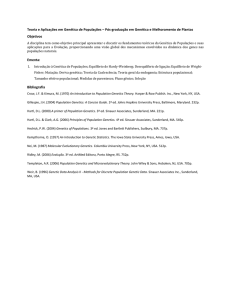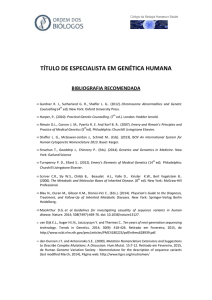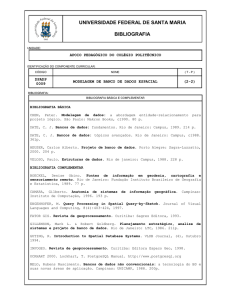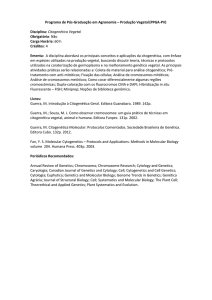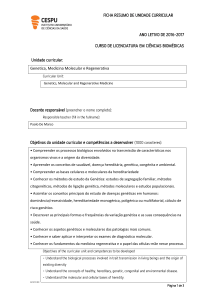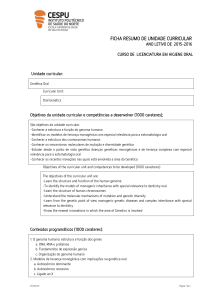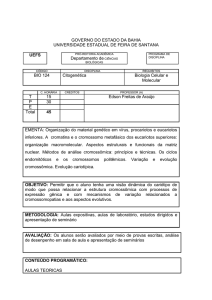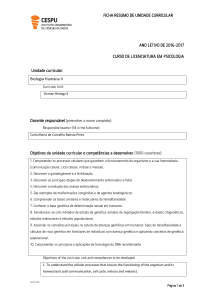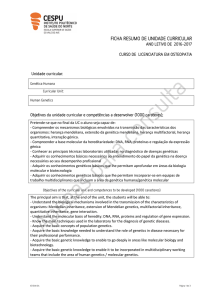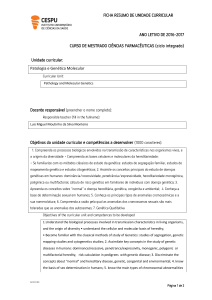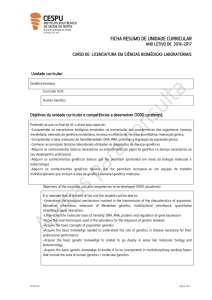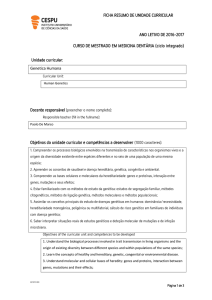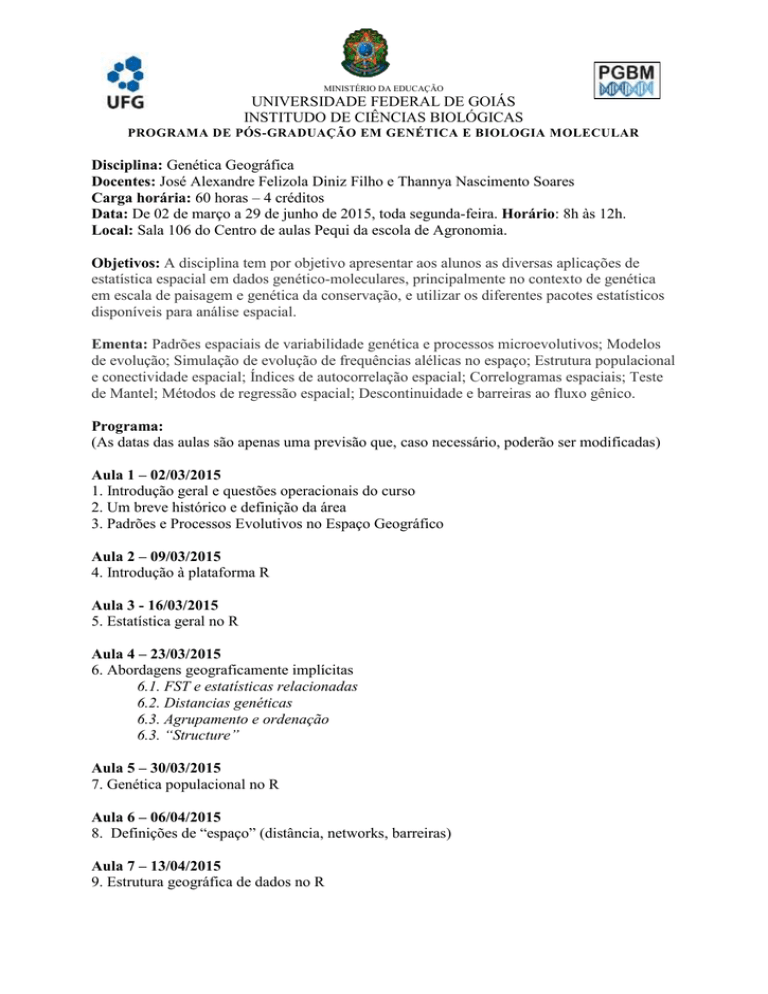
MINISTÉRIO DA EDUCAÇÃO
UNIVERSIDADE FEDERAL DE GOIÁS
INSTITUDO DE CIÊNCIAS BIOLÓGICAS
PROGRAMA DE PÓS-GRADUAÇÃO EM GENÉTICA E BIOLOGIA MOLECULAR
Disciplina: Genética Geográfica
Docentes: José Alexandre Felizola Diniz Filho e Thannya Nascimento Soares
Carga horária: 60 horas – 4 créditos
Data: De 02 de março a 29 de junho de 2015, toda segunda-feira. Horário: 8h às 12h.
Local: Sala 106 do Centro de aulas Pequi da escola de Agronomia.
Objetivos: A disciplina tem por objetivo apresentar aos alunos as diversas aplicações de
estatística espacial em dados genético-moleculares, principalmente no contexto de genética
em escala de paisagem e genética da conservação, e utilizar os diferentes pacotes estatísticos
disponíveis para análise espacial.
Ementa: Padrões espaciais de variabilidade genética e processos microevolutivos; Modelos
de evolução; Simulação de evolução de frequências alélicas no espaço; Estrutura populacional
e conectividade espacial; Índices de autocorrelação espacial; Correlogramas espaciais; Teste
de Mantel; Métodos de regressão espacial; Descontinuidade e barreiras ao fluxo gênico.
Programa:
(As datas das aulas são apenas uma previsão que, caso necessário, poderão ser modificadas)
Aula 1 – 02/03/2015
1. Introdução geral e questões operacionais do curso
2. Um breve histórico e definição da área
3. Padrões e Processos Evolutivos no Espaço Geográfico
Aula 2 – 09/03/2015
4. Introdução à plataforma R
Aula 3 - 16/03/2015
5. Estatística geral no R
Aula 4 – 23/03/2015
6. Abordagens geograficamente implícitas
6.1. FST e estatísticas relacionadas
6.2. Distancias genéticas
6.3. Agrupamento e ordenação
6.3. “Structure”
Aula 5 – 30/03/2015
7. Genética populacional no R
Aula 6 – 06/04/2015
8. Definições de “espaço” (distância, networks, barreiras)
Aula 7 – 13/04/2015
9. Estrutura geográfica de dados no R
Aula 8 – 27/04/2015
10. Abordagens geograficamente explícitas: teste de Mantel
10.1. Teste de Mantel (simples)
10.2. Mantel parcial e múltiplo
10.3. Correlograma de Mantel
11. Autocorrelação espacial
11.1. I de Moran
11.2. Correlogramas e sua interpretação
Aula 9 – 04/05/2015
12. Mantel e autocorrelação no R
Aula 10 – 11/05/2015
13. Correlação e Regressão Espacial
13.1. Correção de graus de liberdade
13.2. Superfícies de tendência
13.3. Modelos autoregressivos e SEVM
13.4. Seleção de Modelos
Aula 11 – 18/05/2015
14. Correlação e regressão espacial no R
Aula 12 – 25/05/2015
15. Descontinuidade espacial (Monmonier, Wombling etc)
16. Descontinuidade espacial no R
Aula 13 - 01/06/2015
17. Estrutura populacional, padrões espaciais e conservação da diversidade genética
Aula 14 – 08/06/2015
18. Prioridades de conservação no R
Aula 15 – 15/06/2015
Avaliação
Bibliografia Recomendada:
Livros
Avise JC. 2000. Phylogeography: the history and formation of species. Cambridge: Harvard
University Press, Cambridge,
Cavalli-Sforza L, Menozzi P, Piazza A. 1994. The History and Geography of Human Genes.
Princeton: Princeton University press.
Epperson BK. 2003. Geographical genetics. Princeton: Princeton University press.
Fortin M-J, Dale MRT. 2005. Spatial Analysis: A Guide for Ecologists. Cambridge:
Cambridge University Press.
Legendre P, Legendre L. 1998. Numerical Ecology, 3rd ed. Amsterdam: Elsevier.
Manly BFJ. 1997. Randomization, Bootstrap, and Monte Carlo Methods in Biology. London:
Chapman and Hall.
Rousset F. 2004. Genetic structure and selection in subdivided population. Princeton:
Princeton Univ. Press.
Diniz-FIlho JAF, Bini LM. 2012. Thirty-five years of spatial autocorrelation in population
genetics: na essay in honour of R. R. Sokal (1926-1912). Biological Journal of Linnean
Society 107: 721-736.
Diniz-Filho JAF, Telles MPC. 2002. Spatial autocorrelation analysis and the identification
of operational units for conservation in continuous populations. Conservation Biology 16:
924-935.
Diniz-Filho JAF, Telles MPC, Bonatto S, Eizirik E, Freitas TR, Marco JR.P, Santos FR,
Sole Cava A, Soares TN. 2008. Mapping the evolutionary twilight zone: molecular
markers, populations and geography. Journal of Biogeography 35: 753-763.
Collevatti RG et al. 2012. A coupled phylogeographical and species distribution modelling
approach recovers the demographical history of a Neotropical seasonally dry forest tree
species. Molecular Ecology 21: 5845–5863.
Eckert CG, Samis KE, Lougheed SC. 2008. Genetic variation across species' geographical
ranges: the central-marginal hypothesis and beyond. Molecular Ecology 17: 1170–1188.
Guillot G, Estoupe A, Mortier F, Cosson JF. 2005. A spatial statistical model for
landscape genetics. Genetics 170: 1261-1280.
Guillot G, Leblois R, Coulon A, Frantz AC. 2009. Statistical methods in spatial genetics.
Molecular Ecology 18: 4734-4756.
Hardy OJ, Vekemans X. 1999. Isolation by distance in a continuous population:
reconciliation between spatial autocorrelation analysis and population genetics models.
Genetics 83: 145-154.
Holsinger KE, Weir BS. 2009. Genetics in geographically structured populations: defining,
estimating and interpreting FST. Nature Review Genetics 10: 639-650.
Legendre P, Fortin M-J. 2010. Comparison of the Mantel test and alternative approaches for
detecting complex multivariate relationships in the spatial analysis of genetic data.
Molecular Ecology Resources 10: 831-844.
Manel S, Schwartz MK, Luikart G, Taberlet P. 2003. Landscape genetics: combining
landscape ecology and population genetics. Trends in Ecology and Evolution 15: 189-197.
Pritchard JK, Stephens M, Donnelly, P. 2000. Inference of population structure using
multilocus genotype data. Genetics 155:945–959.
Reich D., Price, AL , Patterson N. 2008. Principal component analysis of genetic data.
Nature Genetics 40: 491-492.
Richards CL, Carstens BC, Knowles LL 2007. Distribution modelling and statistical
phylogeography: an integrative framework for generating and testing alternative
biogeographical hypotheses. Journal of Biogeography 34: 1833–1845.
Rousset F. 1997. Genetic differentiation and estimation of gene flow from F-statistics under
isolation-by-distance. Genetics 145: 1219-1228.
Sokal RR, Oden NL. 1978a. Spatial autocorrelation in biology. 1. Methodology. Biological
Journal of Linnean Society 10: 199-228.
Sokal RR, Oden NL. 1978b. Spatial autocorrelation in biology. 2. Some biological
implications and four applications of evolutionary and ecological interest. Biological
Journal of Linnean Society 10: 229-249.
Sokal RR, Oden N, Thomson BA. 1997. A simulation study of microevolutionary inferences
by spatial autocorrelation analysis. Biological Journal of Linnean Society 60: 73-93.
Wagner HH, Fortin MJ. 2012. A conceptual framework for the spatial analysis of
landscapegenetic data. Conservation Genetics DOI 10.1007/s10592-012-0391-5.
Vekemans X, Hardy OJ. 2004. New insights from fine-scale spatial genetic structure
analyses in plant populations. Molecular Ecology 13: 921-935.

